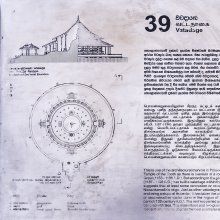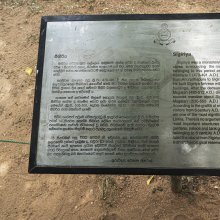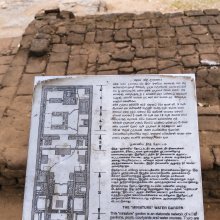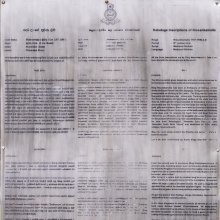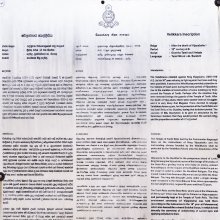Navata, Navaṭa, Navāṭā: 12 definitions
Introduction:
Navata means something in Hinduism, Sanskrit, Marathi, Tamil. If you want to know the exact meaning, history, etymology or English translation of this term then check out the descriptions on this page. Add your comment or reference to a book if you want to contribute to this summary article.
Images (photo gallery)
Languages of India and abroad
Marathi-English dictionary
Source: DDSA: The Molesworth Marathi and English Dictionarynavaṭa (नवट).—a (nava) Still bearing some appearance of newness, newish. 2 Just hewn or chopped--wood. 3 New.
--- OR ---
navāṭa (नवाट) [or ठ, ṭha].—a (Or navaṭa from nava) Newish, still bearing some appearance of newness. 2 Just hewn or chopped--wood.
Source: DDSA: The Aryabhusan school dictionary, Marathi-Englishnavaṭa (नवट).—a Still bearing some appearance of newness, newish. Just hewn or chopped-wood. New.
--- OR ---
navāṭa (नवाट) [or ṭha, or ठ].—a Newish. Just hewn or chopped-wood.
Marathi is an Indo-European language having over 70 million native speakers people in (predominantly) Maharashtra India. Marathi, like many other Indo-Aryan languages, evolved from early forms of Prakrit, which itself is a subset of Sanskrit, one of the most ancient languages of the world.
Sanskrit dictionary
Source: DDSA: The practical Sanskrit-English dictionaryNavata (नवत).—a. (-tī f.) Ninetieth.
-taḥ 1 An elephant's painted housings.
2) A woollen cloth, blanket.
3) A cover, wrapper in general.
Source: Cologne Digital Sanskrit Dictionaries: Shabda-Sagara Sanskrit-English DictionaryNavata (नवत).—m.
(-taḥ) An elephant’s painted or variegated housings. E. nava new, tan to spread, affix ṅa or nū-atac .
--- OR ---
Navatā (नवता).—f.
(-tā) Novelty. E. tal added to nava; also with tva, navatvaṃ;
Source: Cologne Digital Sanskrit Dictionaries: Benfey Sanskrit-English DictionaryNavata (नवत).—i. e. navati + a, ordinal number, Ninetieth, [Rājataraṅgiṇī] 5, 260.
--- OR ---
Navatā (नवता).—[nava + tā], f. Freshness, [Kumārasaṃbhava, (ed. Stenzler.)] 5, 86.
Source: Cologne Digital Sanskrit Dictionaries: Cappeller Sanskrit-English DictionaryNavata (नवत).—[adjective] the ninetieth.
--- OR ---
Navatā (नवता).—[feminine] novelty, freshness.
Source: Cologne Digital Sanskrit Dictionaries: Monier-Williams Sanskrit-English Dictionary1) Navatā (नवता):—[=nava-tā] [from nava] f. freshness, novelty, [Kumāra-sambhava]
2) Navata (नवत):—[from nava] 1. navata mf(ī)n. the 90th, [Rājataraṅgiṇī] (cf. ekadvāetc.)
3) 2. navata m. an elephant’s painted or variegated housings
4) woollen cloth
5) a cover, blanket, wrapper, [cf. Lexicographers, esp. such as amarasiṃha, halāyudha, hemacandra, etc.] (cf. 2. namata).
Source: Cologne Digital Sanskrit Dictionaries: Yates Sanskrit-English Dictionary1) Navata (नवत):—(taḥ) 1. m. An elephant’s painted or variegated housings.
2) Navatā (नवता):—(tā) 1. f. Novelty.
Source: DDSA: Paia-sadda-mahannavo; a comprehensive Prakrit Hindi dictionary (S)Navata (नवत) in the Sanskrit language is related to the Prakrit words: Ṇauiya, Ṇayaya.
[Sanskrit to German]
Sanskrit, also spelled संस्कृतम् (saṃskṛtam), is an ancient language of India commonly seen as the grandmother of the Indo-European language family (even English!). Closely allied with Prakrit and Pali, Sanskrit is more exhaustive in both grammar and terms and has the most extensive collection of literature in the world, greatly surpassing its sister-languages Greek and Latin.
Kannada-English dictionary
Source: Alar: Kannada-English corpusNavata (ನವತ):—
1) [noun] something laid over or wrapped around a thing, esp. for concealment, protection or warmth; a covering.
2) [noun] a large, rectangular piece of woollen fabric, often with bound edges, used esp. for warmth as a bed covering; a blanket.
--- OR ---
Nāvāṭa (ನಾವಾಟ):—[noun] a going on water in a boat as a pleasure-sport.
Kannada is a Dravidian language (as opposed to the Indo-European language family) mainly spoken in the southwestern region of India.
See also (Relevant definitions)
Starts with (+6): Na-ataittupo, Navatai, Navatakem, Navatakkam, Navatala, Navatali, Navataniyam, Navatanka, Navatankanam, Navatantava, Navatantu, Navatanu, Navatara, Navatara-bhumi, Navatarana, Navataranem, Navatardma, Navataruna, Navataruni, Navatarunya.
Ends with (+42): Adhmanavata, Amanavata, Anavata, Apanavata, Ashtanavata, Aurnavata, Banavata, Binavata, Bunavata, Caturnavata, Chaturnavata, Cikanavata, Cikhanavata, Cunavata, Dhungako-banavata, Dronavata, Dvanavata, Dvinavata, Ekanavata, Ekonanavata.
Full-text: Ekanavata, Trinavata, Dvanavata, Dvinavata, Ashtanavata, Saptanavata, Caturnavata, Namata, Navatva, Ashtanavatitama, Nauiya, Kadhim-navata, Dvanavati, Kadhim Navata, Nayaya, Kadhim Na Hotela, Ekonanavata, Pancanavata, Navatai.
Relevant text
No search results for Navata, Navaṭa, Navāṭa, Navatā, Nava-ta, Nava-tā, Nāvāṭa, Navāṭā; (plurals include: Navatas, Navaṭas, Navāṭas, Navatās, tas, tās, Nāvāṭas, Navāṭās) in any book or story.

